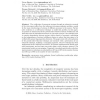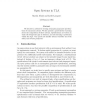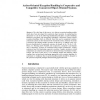JCSC
1998
14 years 6 months ago
1998
For many years, Petri nets have been used for modeling the behavior of various types of concurrent systems. While these net models are especially well suited to capture the behavi...
ASE
2004
14 years 6 months ago
2004
The verification of concurrent systems through an exhaustive traversal of the state space suffers from the infamous state-space-explosion problem, caused by the many interleavings ...
TOPNOC
2008
14 years 6 months ago
2008
Process Algebras are formalisms for modelling concurrent systems that permit mathematical reasoning with respect to a set of desired properties. TAPAs is a tool that can be used to...
CAV
2010
Springer
14 years 6 months ago
2010
Springer
Abstract. We apply model checking of knowledge properties to the design of distributed controllers that enforce global constraints on concurrent systems. We calculate when processe...
ATVA
2010
Springer
14 years 6 months ago
2010
Springer
Abstract. Controlling concurrent systems to impose some global invariant is an undecidable problem. One can gain decidability at the expense of reducing concurrency. Even under thi...
GECCO
2008
Springer
14 years 7 months ago
2008
Springer
Liveness properties in concurrent systems are, informally, those properties that stipulate that something good eventually happens during execution. In order to prove that a given ...
PASTE
1998
ACM
14 years 10 months ago
1998
ACM
FLAVERS, a tool for verifying properties of concurrent systems, uses composite data flow analysis to incrementally improve the precision of the results of its verifications. Altho...
PODC
1994
ACM
14 years 10 months ago
1994
ACM
We describe a method for writing assumption/guarantee specifications of concurrent systems. We also provide a proof rule for reasoning about the composition of these systems. Spec...
ECOOPWEXCEPTION
2000
Springer
2000
Springer
Action-Oriented Exception Handling in Cooperative and Competitive Concurrent Object-Oriented Systems
14 years 11 months ago
The chief aim of this survey is to discuss exception handling models which have been developed for concurrent object systems. In conducting this discussion we rely on the following...
CLUSTER
2000
IEEE
14 years 11 months ago
2000
IEEE
We propose a programming model for distributed concurrent systems with mobile objects in the context of a process calculus. Code mobility is induced by lexical scoping on names. O...



